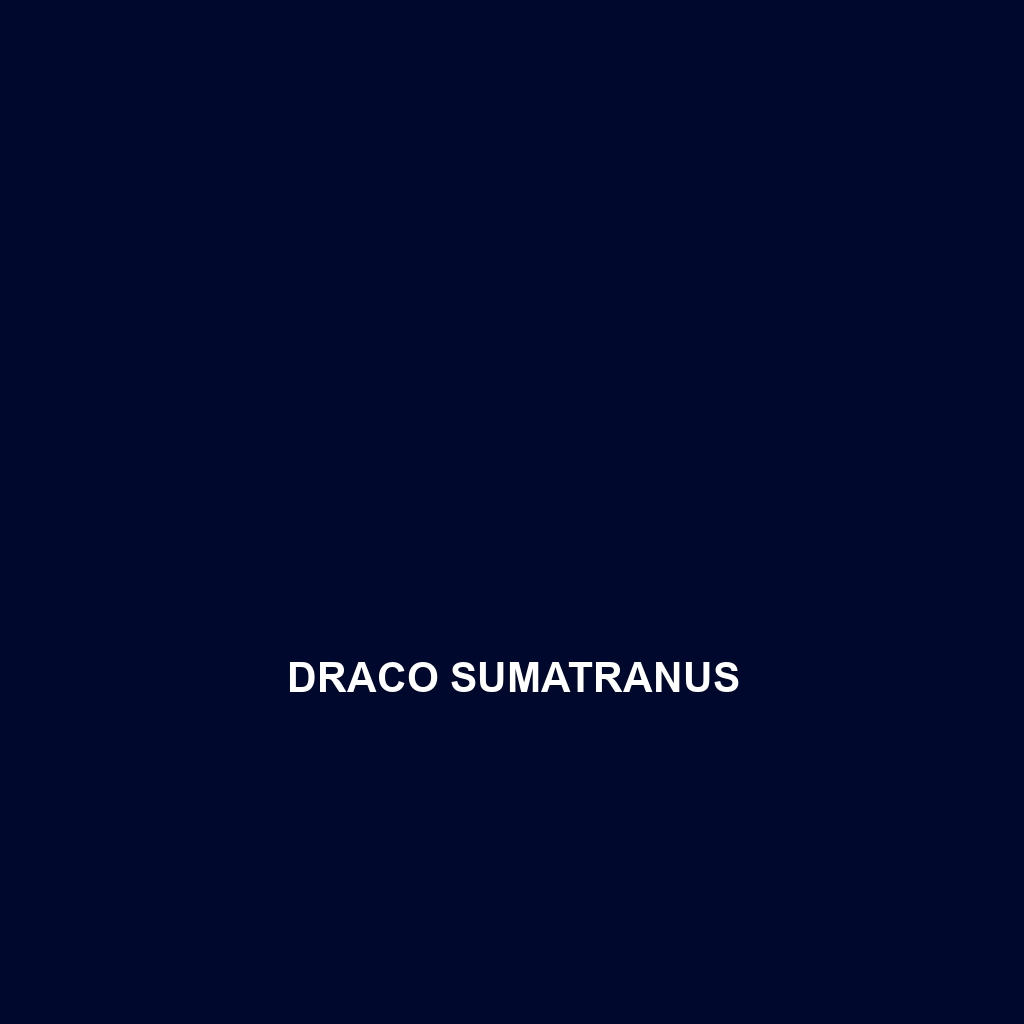Common Name
Draco sumatranus
Scientific Name
Draco sumatranus
Habitat
Draco sumatranus, commonly known as the Sumatran flying dragon or Draco lizard, is primarily found in the lush, dense rainforests of Southeast Asia, particularly on the island of Sumatra, Indonesia. These remarkable creatures thrive in humid, tropical environments that provide ample vegetation for climbing and gliding. The Sumatran flying dragon prefers habitats with plenty of trees and rich foliage, which offer essential cover from predators and a varied diet. It can also be spotted in adjacent areas of secondary growth, gardens, and even slightly drier forest regions, although its primary preference remains these moist rainforests where temperatures are consistently warm and rainfall is abundant. The established ecosystems where Draco sumatranus resides are crucial for its survival, as the ongoing deforestation threatens their habitat and ultimately their population.
Physical Characteristics
Draco sumatranus exhibits a unique set of physical characteristics that distinguish it from other lizards. Typically, this species can reach lengths of about 50 to 70 centimeters, including its tail. One of the most striking features of the Sumatran flying dragon is its elongated body and the presence of wings formed by elongated ribs that extend outward and are covered with a flap of skin, allowing it to glide from tree to tree. The skin coloration varies, displaying a vibrant range of greens and browns, which provides excellent camouflage against the leaves. Their throat flap, called the dewlap, serves an essential function in communication and territorial displays, often brightening in color to attract potential mates or to ward off rivals. This remarkable ability to glide can cover distances of up to 10 meters, making Draco sumatranus an agile and elusive forest inhabitant.
Behavior
The behavior of Draco sumatranus is as fascinating as its appearance. Typically, these lizards are diurnal, meaning they are active during the day, and they exhibit strong arboreal tendencies, spending much of their time atop trees. Social interactions among males can be heightened during breeding seasons, where they engage in elaborate displays involving gliding and dewlap extensions to establish dominance. Although generally solitary, these lizards may be seen congregating in small groups where food resources are abundant. They also exhibit a unique feeding behavior, using their gliding ability to move stealthily between branches in search of food. Draco sumatranus does not migrate but establishes a home range that it defends against other conspecifics.
Diet
Reproduction
The reproductive cycle of Draco sumatranus typically occurs during the wet season, which corresponds with the availability of food resources. Males will engage in courtship rituals that include displaying their dewlap and gliding around potential mates. The gestation period is relatively short, with females laying eggs—usually between 4 to 8 eggs—within crevices or under leaves, where they can remain hidden from predators. After a few weeks, the eggs hatch, and the young lizards emerge fully formed, independent from parental care. The rapid growth of the young Sumatran flying dragons allows them to adapt to their environment swiftly, enhancing their survival rates amidst the challenges presented by predators and habitat loss.
Conservation Status
The conservation status of Draco sumatranus is currently classified as vulnerable due to habitat loss from deforestation and human encroachment. As farming practices expand into rainforest areas and logging activities increase, the natural habitats of these lizards are severely threatened. Conservation efforts are underway to protect these creatures and their habitats, including the establishment of reserves and restoration projects. However, consistent monitoring is required to ensure that the population remains stable and to prevent further decline. Additionally, educating local communities and promoting sustainable land use practices play vital roles in safeguarding the future of Draco sumatranus.
Interesting Facts
Draco sumatranus possesses several intriguing adaptations that help it navigate its environment. For example, its ability to glide is not just for escaping predators but also plays a vital role in locating food and mates across its dispersed home range. Additionally, these lizards can change the intensity of their dewlap color based on their emotional state, indicating readiness to mate or dominance in territorial disputes. The Sumatran flying dragon is also uniquely adapted to blend into its surroundings, which aids in both predation and avoiding detection by threats.
Role in Ecosystem
In the ecosystems where Draco sumatranus resides, it plays a significant role as both a predator and prey. By feeding on insects, these lizards help regulate insect populations, contributing to both plant health and overall biodiversity in their habitat. As consumers of leaf matter and fruits, they also aid in the dispersal of plant seeds, contributing to the growth of new vegetation. Moreover, their presence supports a wider food web, providing sustenance for a variety of predators, including birds of prey and larger reptiles. The Sumatran flying dragon hence is an integral part of maintaining ecological balance within the rich biodiverse environments they inhabit.
